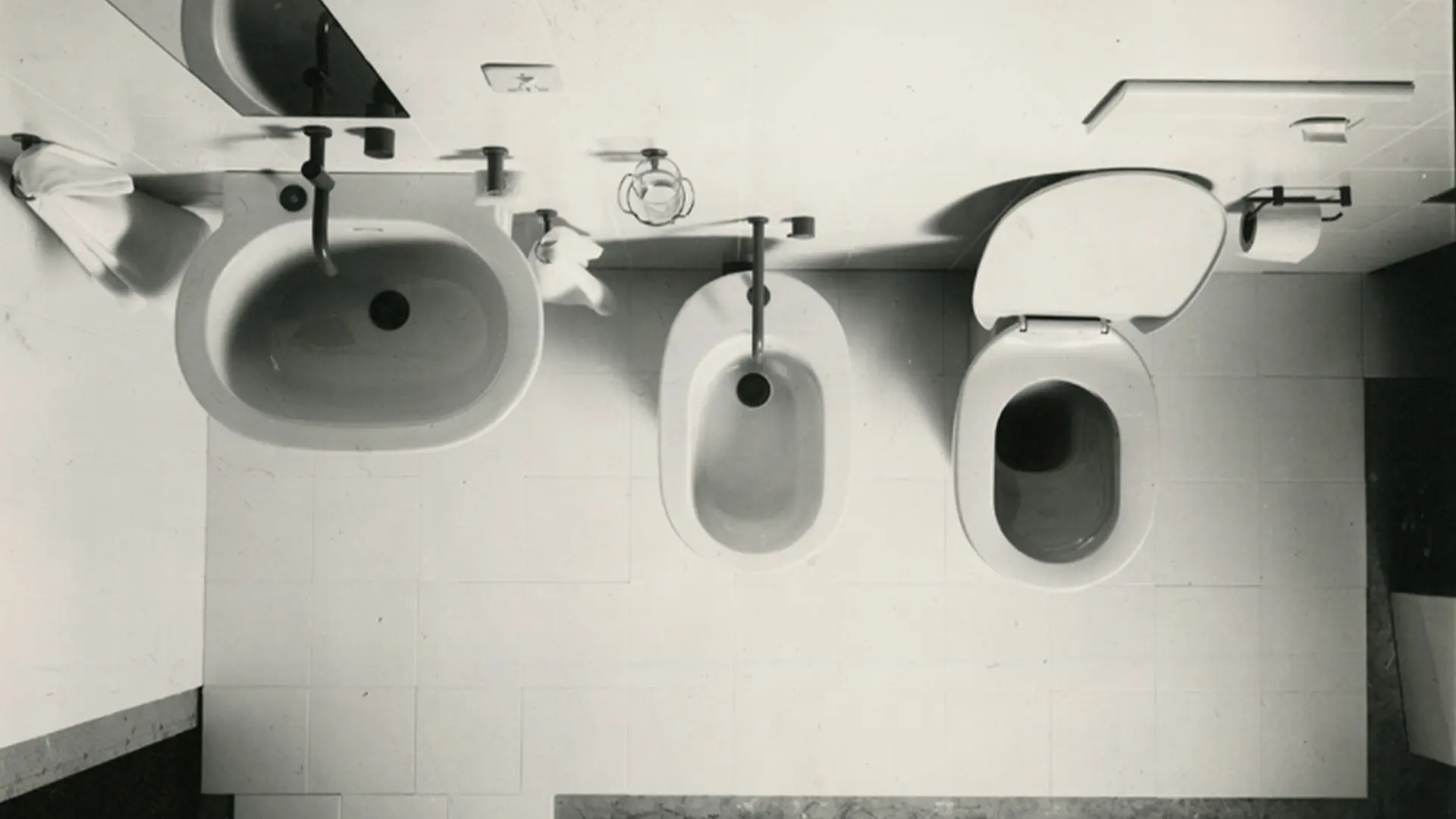In partnership with MiCodmc, a selection of establishments ripe for discovery during the 63rd edition of the Salone del Mobile.Milano, from 8th to 13th April

Linda sanitaryware range, Ideal Standard, public presentation 1977, ph. courtesy Achille Castiglioni Foundation
"...a good project stems not from the ambition to leave a mark, but from the desire to establish an exchange, even a small one, with the unknown person who will use the object ..." Achille Castiglioni
The great Masters were also the precursors of a sphere very familiar to the architects of today: bathrooms. With projects that have remained on paper or brought to fruition. Gio Ponti, Gae Aulenti and Achille Castiglioni, to name but a few, have all done their bit towards enriching the catalogues of, for instance, Ideal Standard, a Belgian multinational dating back centuries, and a pioneer of the introduction of design into the world of sanitaryware, making a huge impact on the way we live.
Castiglioni launched his luxury Aquatonda range (project initiated in 1969) in 1971: “The composition of these new elements makes for a habitable environment, not a place of pure necessity,” he wrote. He was the first to elevate sanitaryware to the status of ceramic objects deserving of exhibition, showcasing them at the various fairs, always along with furnishings. Its public debut was no less impressive – citing Buñuel and The Phantom of Liberty, four Aquatonda lavatories were arranged around a Magistretti-designed table instead of chairs!

Washbasin from the Aquatonda range, Ideal Standard 1971, ph. courtesy Achille Castiglioni Foundation
Aquatonda is a real experiment in material research involving vitreous china, a soft paste that when fired at 1,300° becomes significantly tougher and shinier and, thanks to its intrinsic ductility, allows the sanitaryware to be moulded like sculptures. Functionality, however, remains in pride of place. The washbasin, for example, gets deeper at the point at which the water collects and widens to catch the drops from the elbows of the person using it “and their drips,” he specified; while the front edge was designed ad hoc to contain any splashes. The toilet was designed as a single piece, combining the bowl with the cistern case: “If the tank can be combined with the bowl to make a single piece, it means the hydraulic equipment is no longer visible, something that the Italian market, for example, finds disagreeable in that it is too reminiscent of the old cast iron boxes found in social housing of recent memory,” wrote Castiglioni.
Had Castiglioni been, as he writes, “free to carry out an integral design,” he could have achieved “a more complete revolution,” but he was hamstrung by a number of constraints ... “There were productive and technical problems that obliged the designer to treat the object under consideration as communicating an image closely related to the tradition of this particular space.”

Diagram of inlet and outlet pipes, Linda sanitaryware range, Ideal Standard, 1977, ph. courtesy Achille Castiglioni Foundation
Again for Ideal Standard, in response to a precise request from the company, he started working on a range of sanitaryware that was “smaller in size, but essential in form, destined for the wider public.” Christened Linda, it was introduced to the market in 1977, at the 18th Mostra Convegno fair in Milan, with these words: “Hello everyone! I’m Linda, in miniature! Here on behalf of Linda sanitaryware! The name says it all when it comes to our perfection! No embarrassment or shame! I am Linda, we are Linda, and linda [clean] we wish to remain! Just because I’m a sanitary fitting doesn’t mean I have to be grotty, sorry!”
A washbasin, a bidet and a toilet, all elliptically-shaped, made up the range, designed to be mounted on prefabricated walls, because they had to conform to affordability criteria (from production to installation to maintenance) and to European legislation. Affordability that was later judged to be excessive. The washbasin, wider rather than deep, was designed to fit into small spaces, while the outlet pipe of the toilet was positioned above floor level, to allow for prefabricated connections.
The importance of this range, wrote Castiglioni “lay in the lengthy teamwork, resulting in an outcome that could be described as collective creativity.” Utility, good looks and comfort netted it the 1979 Golden Compass Award.

Preliminary project 1969, plaster model, Aquatonda sanitaryware range, ph. courtesy Achille Castiglioni Foundation
Castiglioni used his eclectic talent to explore the world of bathroom fixtures and fittings with his (1978) Fonte prototype wall-mounted satin-finish steel mixer tap for Teorema, with its rounded, continuous lines. He had previously embarked on an unrealised tap design for Ideal Standard, in 1969.
His pieces also include what is commonly known as a radiator. Castiglioni designed two of these: HP in 1971 and Ritmo, in 1977 for Perani, which garnered an Honourable Mention at the 1979 Golden Compass Awards, and was presented with his customary irony: “Hot? Cold? Shall we turn it on for a bit? No, I’m joking! I’m joking! Yes, I know, it’s the wrong season for this staging … don’t give me that terrified look, I’m off!! ! Really!! I’m freezing … OK take me away, since the women are pulling out their fans just at the sight of me … I can hardly turn up the temperature just by the power of thought, come on !!! OK, OK, let’s go … It’s all auto-suggestion anyway!!!! Auto-suggestion!! You’re going too far ...” It is a modular radiator made of die-cast aluminium elements assembled with nipples that confer a homogeneous look to the heating element. It is also reversible, in that it features the same profile on both sides.
Check out the previews


 Stories
Stories










